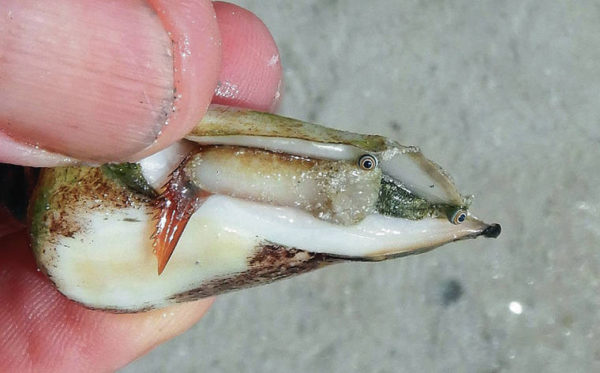Published in the Ocean Watch column, Honolulu Star-Advertiser © Susan Scott
November 2, 2019
Great Barrier Reef Marine Park, Orpheus Island, Australia >> The new moon phase, in which moonlight is absent, not only confuses fledgling shearwaters trying to find the ocean, it also tests sailors. But it’s not the dark nights that challenge us. It’s the tides.
During new (and full) moons, the tides are at their maximum highs and lows. Called spring tides since the 16th century, the name has nothing to do with seasons, but rather with the notion that during these times of the month, the water seems to “spring up.”
 An Australian stromb shows its brown blade
An Australian stromb shows its brown blade
poised on one end and eyes alert on the other.
©2019 Susan Scott
My nautical dictionary says that the term “spring,” regarding tide, may have come from the Anglo-Saxon word “springer,” meaning bulge. Another dictionary says “spring tide” comes from old high German, “springan,” meaning to jump.
Anchoring during a spring tide requires some calculating. If at high tide, as it was last week, we anchored in 10 feet of water, Honu, with a draft of 6 feet, would be high and dry at low tide six hours later.
A low spring tide, however, has its charms. Such as exposing strombs.
Strombs is a nickname of snails in the family Strombidae. Family members are also known as conchs, pronounced “konks.” The snails range widely in size, from Hawaii’s 1-1/2-inch-long stromb called the spotted stromb, or pupu mamaiki, to the pink, 12-inch-long queen conch of Florida and other parts of the tropical Atlantic.
The queen conch is a popular food source, and its heavy shell is often used as a ceremonial horn. Early Hawaiians used the Pacific snail, Triton’s trumpet, as a blowing shell, called pu.
Last week, after anchoring Honu in a safe 20 feet of water, we watched the tide fall until it exposed a swath of reef so shallow that we had to abandon our little rubber dinghy in a sand patch and walk, taking care to step only in silty paths around exposed corals.
My big excitement of the day was finding a sandy section of the bay where hundreds of 2-inch-long strombs lay in about an inch of water. These seaweed grazers were likely waiting for the tide to turn to go about their business of finding food.
One remarkable feature of strombs is their trapdoors, or operculums. In turban snails the shell’s door (sometimes called a cat’s eye) is round and, when pulled in, seals the snail’s soft parts inside.
In strombs, though, the door is a serrated blade that can be used as a wall, weapon or walking stick, depending on the need. When it must move fast to escape a predator, a stromb jams its knife into the sand and leaps, sometimes clearing the ocean floor.
Strombs also have outstanding eyesight. The round eyes are rings of yellow, orange and white on the ends of fleshy, flexible stalks. When we picked up one of the hunkered-down strombs, it raised its tiny dagger and popped its eyes out from behind its muscular foot, watching us with an almost humanlike gaze.
New-moon tides can be a pain for sailors with deep-draft boats, but they also reveal a world we rarely get to see. When else besides a low spring tide would I find a field full of pole-vaulting snails with periscope eyes?